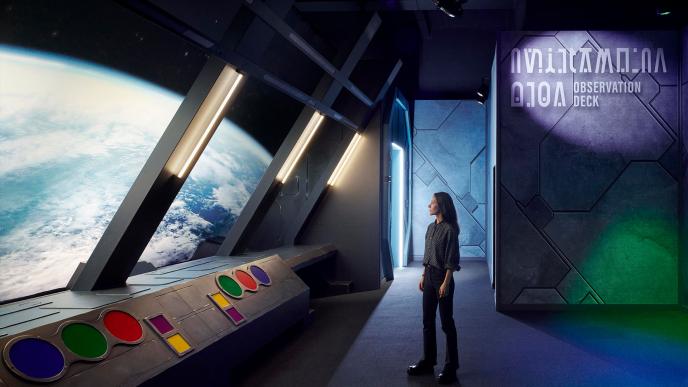
Voyage to the Edge of Imagination
Designed by Framestore, in partnership with P&P Projects, the Science Museum has unveiled its most ambitious exhibition yet: ‘Science Fiction: Voyage to the Edge of Imagination’. Launched on October 6th 2022, it places visitors at the heart of an interactive science fiction story, filled with objects and experiences that explore how scientists and science fiction creators have inspired each other through innovation and Imagination.
Framestore collaborated with the museum’s curatorial and interpretation team from the outset to conceive of the exhibition as an immersive story.
Framestore Creative Directors Gavin Fox and Henry Trotter worked alongside Executive Producer Lauren Anderson to create an immersive adventure through the cosmos aboard a spaceship, featuring an Al Guide and new extra-terrestrial language created exclusively for the exhibition.
The Science Museum approached Framestore with the project almost three years ago, deliberately looking for companies that would offer a different perspective to experience led design. “What they liked about us was not just our credentials in the science fiction world, but our approach to creating compelling immersive worlds and storytelling,” comments Henry Trotter. “They wanted us to tell a story in an unconventional way. They wanted this to be a journey that the audience can walk through, full of drama, revelations, and a meaningful sense that you have arrived at a different destination from where you started, both physically and emotionally.”
Framestore partnered with P&P Projects, a Dutch scenic design company that specialises in bringing to life cinematic worlds in theme parks and high end attractions, having previously collaborated with them on the Jurassic World attractions in Universal Studios Beijing. Gavin Fox notes, “Together, our role was to define a story and physical space that would provide a realistic science fiction adventure, exploring the link between the genre and genuine science- not forgetting that this design would also have to be flexible and robust enough to tour the world for the next five years.”
“For us, the big production challenge was to consider how every element, from visitor throughput, story, and interactivity, to physical build, lighting and sound design - all elements provided by multiple different vendors - would fit together to create a single immersive experience for visitors,” reflects Lauren Anderson. “But those are the kind of challenges we come up against all the time in Framestore’s Immersive Team - and we could bring all that experience to this ambitious project."


One of the most exciting elements of the exhibition is the surprise trip to a distant planet, where guests have a close encounter with an ethereal alien lifeform. Gavin explains, “There’s actually a swarm of thousands of glowing creatures whose movements are deliberately unusual and hard to figure out, because we don’t understand them, and they don’t understand us - and it’s all rooted in scientific theory to make it as real as possible for the visitors.”
Commenting on the technology involved, Gavin adds, “To create this real time mysterious encounter, we used multiple LiDAR scanners to track different groups of guests simultaneously, which drives interactive lighting, immersive sound design, and a multi-array projection dome featuring a real time Unreal Engine visualisation of our extra-terrestrial beings.”
The notion of leaving the familiar behind is also emphasised by the use of the alien language called ‘Bhaux’ throughout the ship. Designed by Gavin Fox using a language creation tool customised to give a realistic grammar and structure, this alien language is intended to be different to any earthly language.
“The aim was to ensure that the Bhaux language looked genuinely alien, so a phrase such as ‘Exploration Deck’ may be made up of a very different number of characters, or even more than two words, once it has been translated,” Gavin explains. “We also created a custom typeface in four weights to give the text a different character around the ship - so even if you know what it says, you can understand the tone. For example, in the heavily industrial Cargo Bay, the text is bold and impactful, while in the Bio Lab we have a much more sophisticated feeling, so the text is a very light weight using simple monotone colours.”
For this specific exhibition the project team drew heavily on their immersive storytelling skills. Henry Trotter expands, “Previously, we’ve often designed individual parts of a bigger experience; on this occasion our focus has been more on a complete experience design, telling a story using every available element within the wider design.”
He continues, “We applied the experience we have gained in immersive theme park rides and attractions, where the design is based on a known story, in a way that can still surprise and actively involve the audience. Though the story in this exhibition is original, it is still grounded in tropes from multiple science fiction stories. We’ve tried very hard to strike that balance, crafting a fascinating new adventure while hinting at stories people already know and love - and, of course, there are easter eggs littered throughout, subtly woven into dialogue, signage, soundscape, and scenery.”
Reflecting on his experience, Henry says, “A personal highlight from this project was seeing Gav’s alien language coming to life, the subtleties of the structure of the grammar and the huge extent of the vocabulary, and realising this experience had the potential to be as deeply immersive as we had wanted it to be.”
Gavin adds, “For me, I’ve loved finalising the project, seeing the real physical world being pieced together in the Science Museum. Not only is it amazing seeing all of these ideas come to life, but the last minute problem solving, getting people together from so many disciplines literally stood around in a circle with paintbrush, power tool or architectural plan in hand, to make sure every detail stays correct to the world we’re creating - that is really such a fun and rewarding part of the entire project.”


PRESS
Podcast: Designing the Immersive exhibition for the Science Museum in London - Befores & Afters


